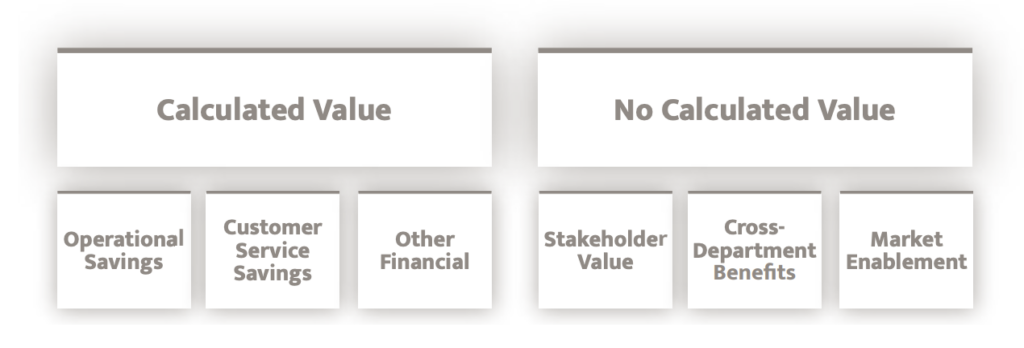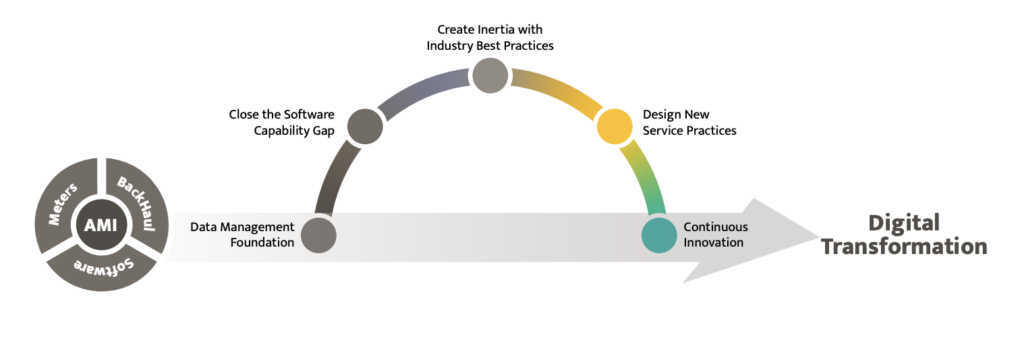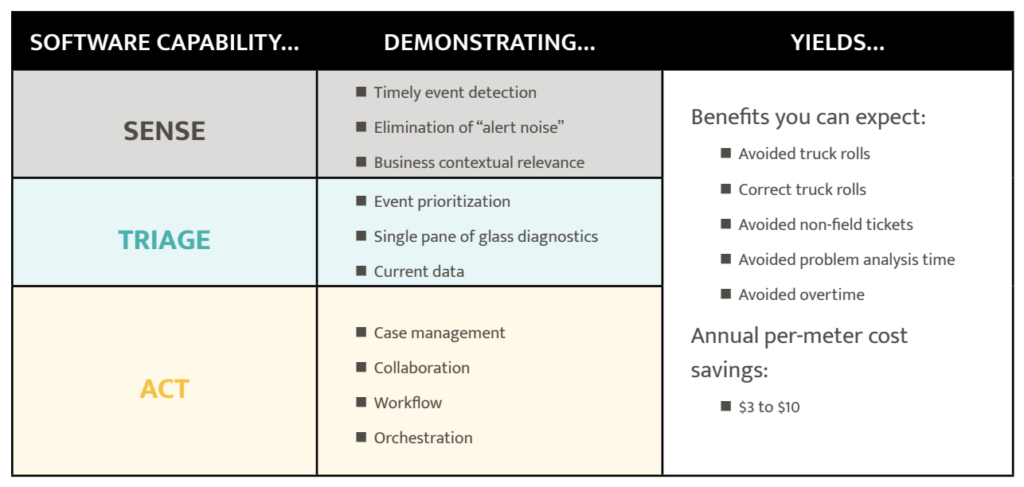AMI Value Realization: Unlocking the Promise of AMIplus
Click here to download this white paper as a PDF.
The Challenge of Capturing AMI Value
The lack of real-time, high-fidelity observability in the low voltage grid has been the consequence of technology limits of the age, leaving hard and soft value on the table for distribution utilities. The introduction of Advanced Metering Infrastructure (AMI) opened the way towards capturing this value for stakeholders. AMI is a large, high-profile investment, and the path to implementation is often through an application process rooted in a rate case, an AMI Proposal, or a portion of a broader Grid Modernization proposal.
There are utilities that have deployed AMI and are realizing benefits for customers and across the utility enterprise. There are also examples of utilities that have not achieved the benefits included in the business case or that are using AMI solely to measure and bill consumption. These inconsistencies – even if it is only one example – are sowing the seeds of doubt in the minds of some commissions, advocates, and other stakeholders.
AMI proposals often take the form of a digital transformation project with significant positive changes identified in the business case. Leading research firms have determined that less than 30% of digital transformation projects are successful!
The US Department of Energy Advanced Grid Research (AGR) division recently performed a study of 100 significant AMI deployments. The common business elements that pop up throughout AGR’s study are depicted in the graphic below.

The Bridge to AMI Value
A common assumption within AMI initiatives is that the path to digital transformation is 1) AMI meters, 3) data communications network, and 3) the “head end” and “MDM” systems.
This is an incomplete view of the path; one that excludes several critical ingredients: data management practices, filling software gaps, and service process design.
Let’s examine this further.

Data Management Foundations
High data latency is antithetical to digital transformation. The creation of a new stream of AMI grid telemetry offers little contribution towards digital transformation if it remains locked up in head-end databases, released for secondary usage via nightly batch jobs. An early decision that all AMI-enabled utilities should take up is the commitment to the implementation of a stream of data to enrich new or improved business processes. This applies to AMI meter telemetry as well as traditional line-of-business data (LOB) sources (MDM, CIS, etc.).
What does this mean in practice? Principally it means accurate data when and where it is needed to service business processes. There are common patterns for achieving this that are likely already in use; and these are not difficult, expensive, or risky. Utilities can look to their information technology (IT) department to design and implement this crucial ingredient of digital transformation.
Closing the Software Capability Gap: Sense, Triage & Act
“Sense, Triage & Act” each refer to core technology capabilities associated with the Internet of Things (IoT). Hints of these capabilities are found within “head end” and MDM software solutions, but what we refer to here is an emerging state of the art with respect to IoT-enabled businesses.
Sense
Real-time anomaly (event) detection using a robust stream of data. AMI meters provide a degree of edge detection, but this expands that capability wherein the AMI data stream is continuously cross-referenced with LOB data to identify process-contextual, prioritized, customized events spanning service delivery, service quality, IT support, and billing and revenue functions.
Triage
Enormous amounts of time are (can be) spent diagnosing events. The ‘alt-tab’ user experience is common as employees navigate across a multitude of software systems to query data; systems not often designed for diagnostic work. Typical data needs include most recent telemetry, history records for the asset/premise/account, geographical data, and network connectivity. Utilities need a ‘single pane of glass’ for current and relevant information associated with an event; and usually this information is the very same information needed to perform automated event detection.
Act
Event resolution takes a myriad of forms across many utility functions, depending upon the nature of the event and the triage process. To avoid the “tribal knowledge trap”, utilities need a flexible case management system a customizable and interactive workflow capability, and one that can orchestrate work across existing legacy systems.
Creating Early Wins With Industry Best Practices
The utility community is excellent at sharing information with peers. On this path to AMI value utilities The utility community is excellent at sharing information with peers. On this path to AMI value utilities need not reinvent the Sense, Triage, and Act practices that have already been pioneered. Utilities should look for easy to deploy, easy to adopt best practices.
Industry Best Practices
- Meter failure response
- Billing risk management
- Power quality monitoring
- Alarm noise management
- Data model assurance
- Revenue protection
Continue Winning With New Service Processes
When the utility organization can begin to design their own Sense, Triage, and Act service processes they begin to maximize measurable operational cost savings. Evidence found within the industry suggests the following attainable results:

It is important to avoid software capabilities that require laborious and expensive change cycles. Such problems are a legacy of the client-server era that have been nearly eliminated by cloud-native SaaS solutions adhering to single-version, serverless architectures.
Of course, lower operational costs are synonymous with improved KPIs for network service and customer satisfaction.
At this point the utility has realized a great deal of measurable benefit from the original AMI investment. Better yet, momentum towards what is ultimately possible is now very achievable. That momentum takes the form of “continuous innovation”, an important aspect of digital transformation.

Continuous Innovation – The Ultimate AMI Promise
The potential for continuous innovation in this context is best embodied by a prospective question: “what if I think of a new condition to detect within the grid?” This is the point where innovation is usually stymied by a very long software change lifecycle. The ability to experiment towards failures and successes can’t be limited by rigid software paradigms. The entire Sense, Respond, and Act capability chain needs to be able to react quickly and with flexibility to ideas.
What does “quickly and with flexibility” look like?
Sense
Robust parameterization for existing detection logic, and where detection logic does not exist the ability to see new logic (algorithms) within the software in short timeframes.
Triage
The software should have the ability to ingest new data and varied data and make it available within the diagnostic interface.
Act
New workflows of various types should be easily created and edited by system users.
AMIplus, With Trynzic
Trynzic’s SaaS solution, Trynzic for Utilities, requires no per-utility software customization and offers a library of best practices immediately applicable towards identification of common event scenarios.
Experimentation
Trynzic’s CERE provides robust change cycle support including non-production tenant instances with downward data/config cloning and upward config closing features. This allows nondestructive testing and iteration supported by the utility’s live data stream.
Introduction of New Functionality
Trynzic’s CERE is a SaaS solution architected with strong support for continuous integration, continuous deliver (CI/CD), and feature-flagging for feature rollout. As a result of these investments, our targeted duration for delivering new requested detection algorithms is 30 days.

It is this continuous innovation characteristic that unlocks the full potential and promise of your AMI investment:
- New customer experiences
- Modernized employee experiences
- Readiness for future IoT solutions (within and beyond the meter)
- Readiness for managing new business models
The path to AMI value realization is transformative. Trynzic’s mission is to enabling utilities’ business success by replacing Run to Fail with Sense, Triage, and Act.